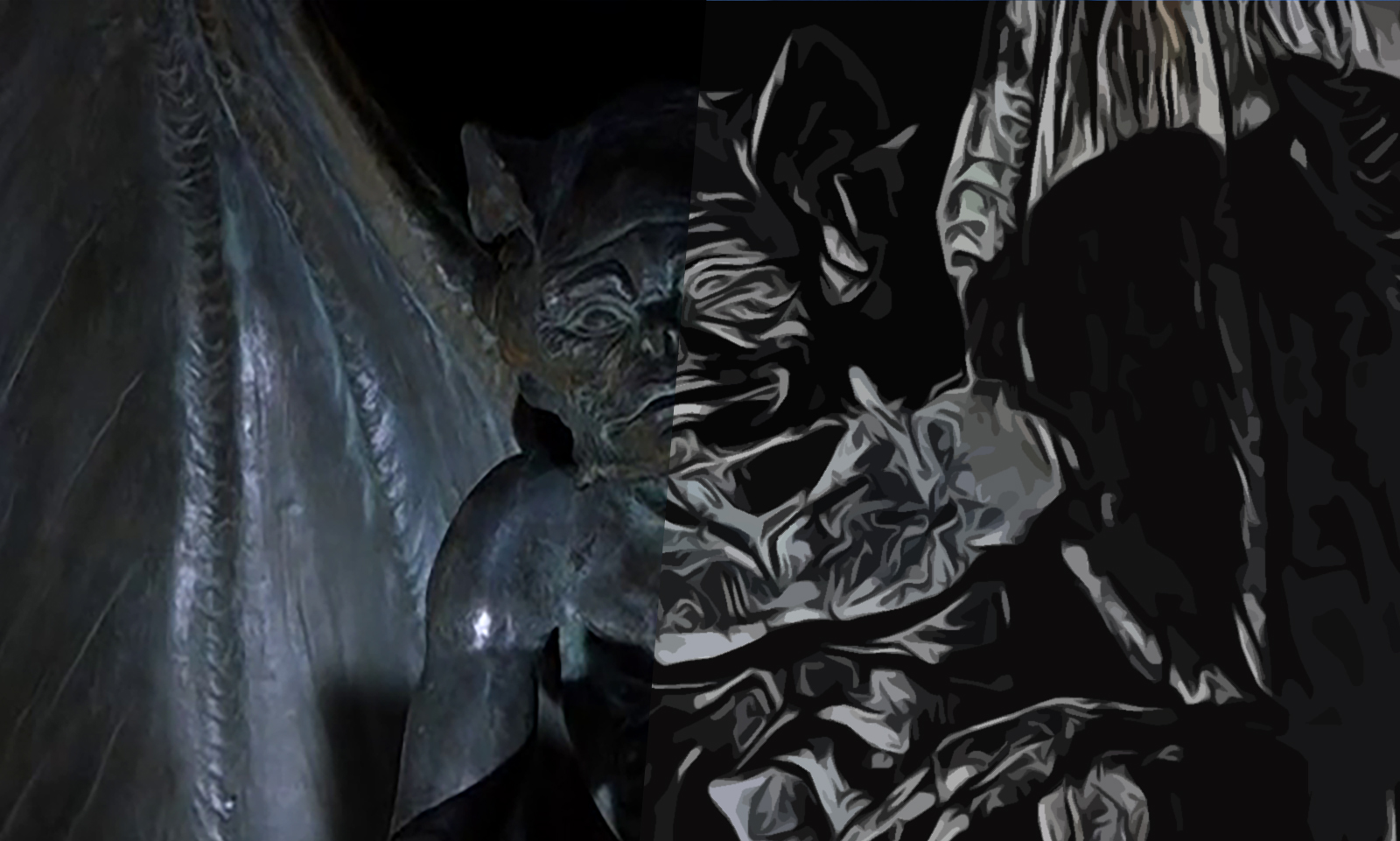Gargoyles are weird things. They are literally little frozen monsters hanging off a building, warding off… things. But for horror, they have a rich history and are a great tool for storytelling. Aside from being a depiction of the purely gothic, they are synonymous with the genre. That can also be said for mummies, black cats, and certainly women wanting to eat little children.
And so we come to Tales from the Darkside: The Movie, a 1990 film adaptation of the cult favorite television show. A film that implements all of these tropes to great success. Directed by John Harrison, it is often considered the unofficial Creepshow 3 and remains a favorite anthology for many who grew up with it.
The selection of tales is fascinating. Each one of them have unique connections to folklore or are cemented solidly within a long tradition of horror tropes. By examining each one, we find many parallels to storytellers throughout the ages.
Hansel Unchained
[image lightbox=”1″ caption=”Supper time.” alt=”Tales from the Darkside Movie wraparound”]https://www.scarystudies.com/wp-content/uploads/2021/01/tales-from-the-darkside-movie-wraparound-1.jpg[/image]The wraparound story is clearly an homage to Hansel and Gretel set in modern times. But even Hansel and Gretel has a complex history. It is often attributed to an origin from various sources dating back to the Middle Ages, though elements like the traditional “breadcrumbs” and outwitting a witch-like figure find parallels in Greek and Roman tales such as Theseus and the Minoan labyrinth.
Hansel and Gretel are abandoned, and must fend for themselves. As Jack Zipes a famous professor and lecturer on German literature discusses, many of the Grimm’s tales and Hansel and Gretel in particular often reinforced cultural desires and stereotypes of the elite, and not particularly accounting for views of the poor in any fair light. In this case, Hansel and Gretel are clearly representative of the poor, in some ways representing how children were often set out to do farm work in neighboring areas, and they reinforce negative aspects of being poor. Namely, abondonment of children. In the original tales the children are purposely abandoned in the woods by their parents. Hansel and Gretel emphasizes what was common at the time, that children needed to make their own way through the horrors of the world without any “handouts” or assistance from their parents. Although I made an entire documentary that discusses children’s ability to take on horrific tales and images, Hansel and Gretel in some ways propagates the idea that it is healthy for poor children to not be given any parental guidance. It’s okay, poor kids. While your richer counterparts don’t need to worry about scary woods and wicked witches, you’re better off figuring things out on your own.
Fast forward to Tales from the Darkside The Movie. Little Timmy doesn’t even have a sister like Gretel to help him. He is all alone. This tale encapsulates most of the traditional Hansel and Gretel tropes, including this same “where are the parents” trope and a suburban rich “witch” that he has to outsmart. We aren’t given any news bulletins about a search for the missing child. We don’t hear about parents and how Timmy misses them. He screams for help and he gets none. Timmy has to deal with this nasty suburban “mom” all by himself. And we cheer him on.
I’m not saying we aren’t allowed to cheer on a youngster outsmarting adults. That’s great. But it’s also healthy to acknowledge that sometimes, and in the case of poor children, it’s certainly healthy for there be a parent available so that children aren’t constantly being susceptible to the rich and their appetites.
Steve Buscemi Meets His Mummy
[image lightbox=”1″ caption=”Nice try.”]https://www.scarystudies.com/wp-content/uploads/2021/01/tales-from-the-darkside-movie-mummy-1.jpg[/image]Starring Steve Buscemi, Christian Slater, and a young Julianne Moore in her first film role, Lot 249 takes the traditional mummy myth and adapts it for a tale of a jealous classmate out for revenge. And a revenge tale is exactly what a good mummy story is natural for.
As I describe in my Joblo video series, this mummy and many traditional tales take the form of “revenge monsters”… a creature that’s sole purpose or place in the story is to enact revenge. In the case of this mummy as well as the classic Golem monster, the creature comes to life because of a person and inhabits their revenge. Frankenstein’s monster is similar as well, but as I point out, Frankenstein could be considered a stand-in for humanity. His revenge is his own, not another’s. His revenge is on God, who put him in a cruel world.
In the case of mummies and golems, they are a stand-in for revenge itself. They embody the hate of a person. And so how the story plays out is a statement about how hate and revenge affects the person who is consumed by it. In Tales from the Darkside The Movie, mummy has a grudge. This mummy is being told who to kill, but how he does it is a sort-of revenge for the way people treated him in his times… brains being pulled out through his nose, his backside being stuffed with flowers. He is creating more mummies. In this way, the idea is that Steve Buscemi’s Bellingham is creating more hate in the world by enacting his hate on others.
The moment you fulfill your revenge, you have created a monster that must seek revenge as well. It is a never-ending cycle of revenge. One can only imagine that Christan Slater’s Andy becomes a mummy in the end and goes on as well. When we act on our hate, we create a monster that begets more hate – forevermore.
— FOUNDATIONS OF HORROR —
Further explore these subgenres & tropes. more>>
#Animals are Scary | #Cannibal horror | #Revenge is Sweet | #Horror Love Story | #Capital M Monsters | #Egyptians: I Want My Mummy

That Black Cat
[image lightbox=”1″ caption=”Oh. Hai Mark.”]https://www.scarystudies.com/wp-content/uploads/2021/01/tales-from-the-darkside-movie-cat-1.jpg[/image]The Tales from the Darkside The Movie “Cat from Hell” segment originates from a short story by Stephen King. Which makes complete sense. Stephen King has a long history of using animals as a vessel for his horrors.
In this story William Hickey’s Drogan is a rich man. One who can avoid death longer than most, thanks to his own pharmaceutical company and their new remarkable drug. As the people around him begin to die, he sees their deaths as a result of this black cat, which in his telling is directly or indirectly the cause of their deaths. He recalls these to David Johansen’s Halston, who has been brought to Drogan’s mansion to kill the cat once and for all.
In some ways this is another Revenge story. Dragon sees the cat as taking revenge for the many cats his company murdered for the purposes of drug testing. But also, it is a tale of death and the efforts we go to, especially the rich, to avoid the inevitable. This old gentleman watches the people around him die one after another. Although in the colorful flashbacks we see the cat is responsible, in actuality they can all be explained through normal means. People have accidents. People die in their sleep.
It isn’t until the end when Halston takes on the cat himself and we get the most insane part of the story that anything unusual actually happens. Everything else about the story involves a cat doing what cats normally do. And an old man fixated on cheating death looking at something suspiciously as a harbinger of his own demise.
More than anything, I see parallels between this Stephen King tale and Edgar Allen Poe’s famous poem The Raven. Both have men who are taunted by death in different ways by a seemingly malevolent animal. While Poe’s narrator is troubled by a lost love, King’s protagonist is a greedy old man.
Gargoyle Girls from the Darkside
[image lightbox=”1″ caption=”About time to trim those nails.”]https://www.scarystudies.com/wp-content/uploads/2021/01/tales-from-the-darkside-movie-gargoyle-1.jpg[/image]From mummies, to black cats, and now to the infamous gargoyle. In the Tales from the Darkside movie gargoyle relationships are rough. There’s no doubt about that.
In this final tale we find down-on-his-luck artist Preston played by James Remar. He has a traumatic night where he comes in contact with a deadly creature. He makes a promise never to speak of what happened ever again. And then… comes Rae Dawn Chong’s Carola into his life.
It’s a sad tale. It also is a loose adaptation of several famous folk legends.
For the Tales from the Darkside movie gargoyles are an opportunity to explore something very similar to the Kumiho legend of Asian lore, and to a lesser degree the “The Girl with a Green Ribbon” tale most famous from Alvin Schwart’s In a Dark Dark Room.
In all of these cases, there is a woman with a secret. Traditionally this had a lot of gross insinuations and connotations… tales being told from one man to another about how women can’t be trusted, that sex workers carry diseases, and ultimately that women themselves often have scary secrets that men must be fearful of. That is certainly the case of the Kumiho legend… and the Green Ribbon story, though a children’s tale, has imagery that encourages rich storytelling regarding women’s psychology and their place in culture. Carmen Maria Machado’s Her Body and Other Parties is a wonderful book that dives deep into the subtext of stories like these, specifically the green ribbon story.
In Tales from the Darkside’s gargoyle allegory “Lover’s Vow” the woman Carola never truly shows herself to her husband. He doesn’t want to see it. And underneath all of these tales of women and their secrets, that is the subtext under the surface, waiting to be unwrapped. That women may have a secret, but it’s because men have created a world in which the men must feel safe. They must be in control. They don’t want the woman to show what is behind the green ribbon or what is underneath their skin. Men can’t handle it. Underneath, there is sadness and pain, but it is too much for men to understand. It’s ultimately something they can’t control or fight against or rationalize. There is no fixing it. And that isn’t something men want to see.
Last Updated on June 25, 2021.

